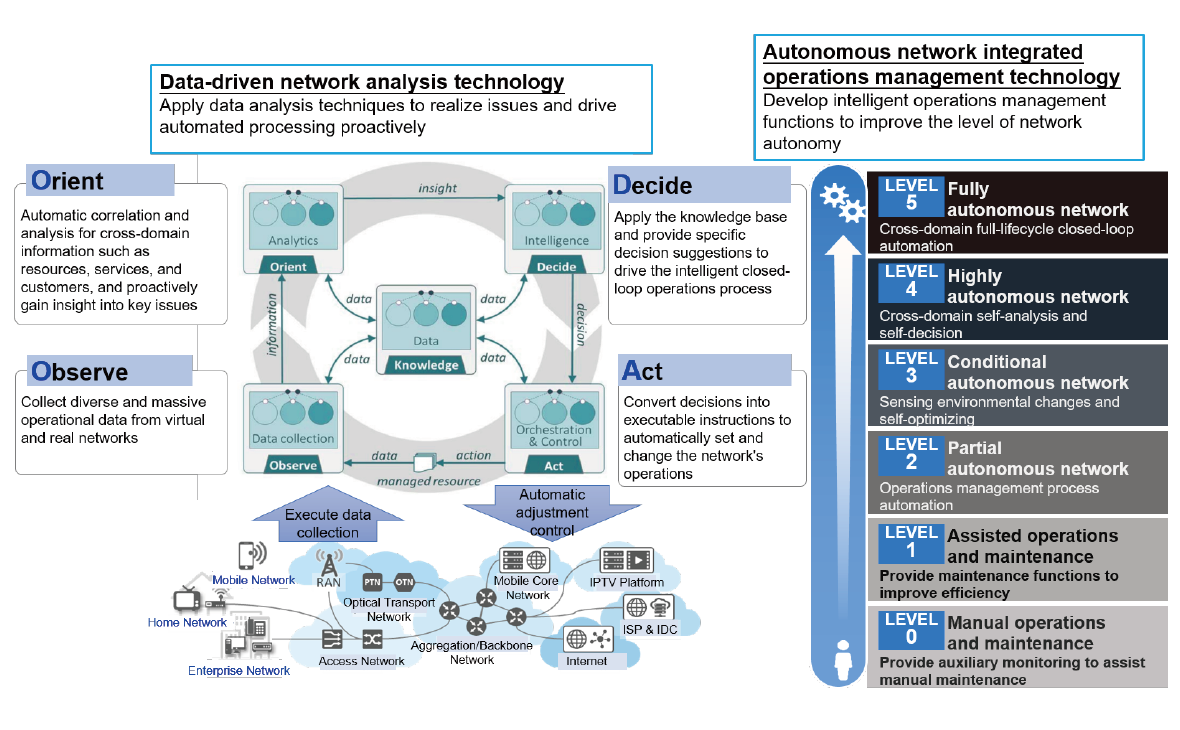DATA-DRIVEN AUTONOMOUS NETWORKS
Overview
According to Gartner, a global technology research and consulting firm, data-driven decision making is one of the keys to the evolution of the telecommunications industry. With the proliferation of ultra-high-speed mobile and fixed broadband network services, diverse mobile network devices and service applications, the ability to quickly process, store, and further intelligently analyze massive amounts of data transmitted or recorded by the network is even more critical. TM Forum also noted that data-driven intelligent network operations are no longer a nice-to-have but a must-have for telecom operators. Meanwhile, improving network management and customer experience are short-term development priorities.Chunghwa Telecom Laboratories develops its own OSS/BSS and is committed to the development of data-driven analysis and autonomous network integrated management technologies. By integrating generative AI and network digital twin technologies, we are building an AI-driven autonomous network. This will reduce maintenance costs and drive optimization actions such as dynamic resource scheduling based on resource usage, locating the root cause of service obstacles, predicting quality degradation, automatic reconnection, clearing communication channels, etc. The above actions will make the network more autonomous and intelligent, improve service quality and user experience, create an open and connected operations management ecosystem, establish intelligent/automated operations and maintenance processes, save labor and maintenance time, and accelerate time to market for new businesses.
DATA-DRIVEN AUTONOMOUS NETWORKS
CORE TECHNOLOGY
- Data-driven Network Analysis Technology
- Autonomous Network Integrated Operations Management Technology
- Generative AI and Network Digital Twin Technology

Vision of Data-driven autonomous network operations management
DATA-DRIVEN AUTONOMOUS NETWORKS
Application Status
Data-driven Network Analysis Technology:"Intelligent Diagnosis of Root Causes of Broadband Network Obstacles" combines various AI/ML analysis methods to provide an end-to-end intelligent diagnosis of broadband customer complaints (of the entire service path). In addition, our system can identify problems and automatically dispatch maintenance personnel to replace many manual operations and improve the accuracy of dispatching. "Trend Analysis of Important Operational Indicators for Network System" automatically collects multiple operational data, creates a trend analysis function for common operational indicators of network services, provides early insight into changes in network quality caused by significant events, and develops countermeasures to improve network service quality (i.e., network robustness/stability). "Information security analysis of telecommunication network equipment" automatically collects the vulnerability information released by the US National Security Vulnerability Database, makes a comparative analysis, reports the network equipment exposure situation, accelerates vulnerability fix and processing efficiency, and shortens risk exposure risk time.
Autonomous Network Integrated Operations Management Technology: "Dynamic optimization, adjustment and activation for broadband service circuit" automatically collects and analyzes hundreds of millions of broadband user traffic and the number of users and bandwidth of aggregated circuits, dynamically analyzes the load status of aggregated circuits, and provides the best solution for new users. In addition, our system streamlined switching decisions to improve the bandwidth utilization efficiency of aggregated circuits. "Circular Control of Image Quality of Audio and Video Services" guarantees subscribers’ viewing rights during live broadcasts of large-scale events. Our platform can monitor audio and video output traffic, automatically warn when usage exceeds a threshold, and dynamically adjust the image quality level of channel output to optimize the bandwidth utilization of the platform. "Automatic loading analysis and line switching of broadband aggregation network circuits" is the key technology to achieving closed-loop automation through the collaboration of four integrated types of OSS (Operations Support System). In addition, it provides traffic analysis and automatic line switching, which are automatically and uninterruptedly executed during the line switching process without affecting user services.
Generative AI and Network Digital Twin Technology:Developing a Fixed-Mobile Network Maintenance Assistant that integrates a shared large language model (LLM) engine and retrieval-augmented generation (RAG) framework to provide document retrieval, report analysis, fault localization, and troubleshooting recommendations. Establishing a Digital Twin Native Service Quality Assurance System to provide visual monitoring, intelligent predictive simulation, and cyber-physical operational management capabilities.

